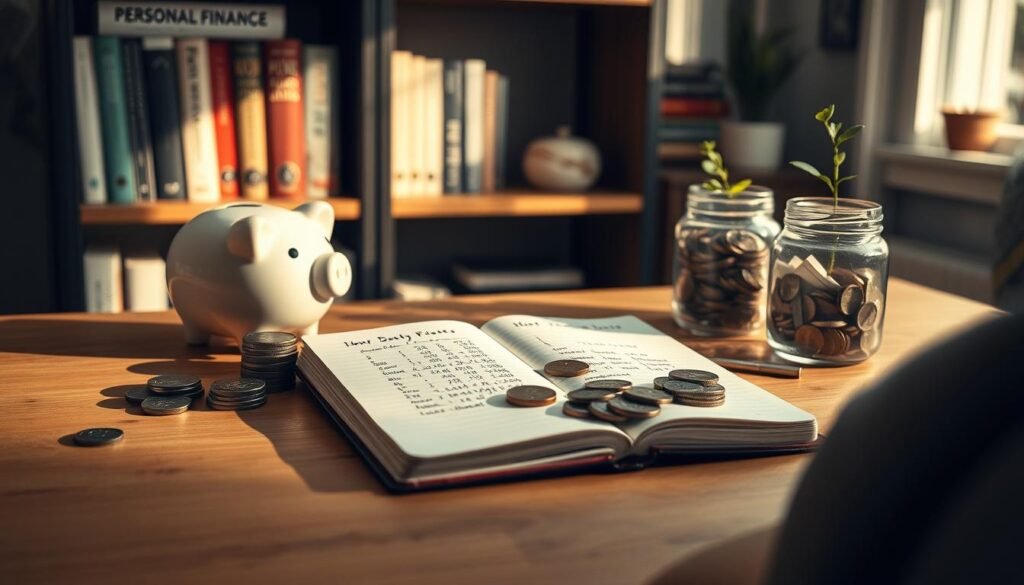
30-Day No-Spend Challenge: Does It Really Work?
Posted in :
I recently tried the 30-day no-spend challenge and was amazed at what I learned. It’s simple: don’t buy things you don’t need for 30 days. This helps you get better at managing your money.
As I looked into it more, I found out many people are trying this money-saving challenge. They want to save money and pay off debt.
In this article, I’ll share my experience and insights. I’ll tell you if the 30-day no-spend challenge really works. And how it can help your financial health.
Key Takeaways
- Understand the concept of the -day no-spend challenge.
- Learn how to prepare for the challenge.
- Discover strategies to succeed during the challenge.
- Find out how to maintain new spending habits after the challenge.
- Explore the benefits of participating in a money-saving challenge.
What Is a 30-Day No-Spend Challenge?
The 30-day no-spend challenge means not buying things you don’t need for a month. It’s a way to test your willpower and learn better spending habits.
This challenge is more than saving money. It helps you understand your spending and make better financial choices. By avoiding unnecessary buys for 30 days, you learn about your spending habits.
The Basic Concept
The 30-day no-spend challenge is simple: don’t buy things you don’t need for 30 days. This means no dining out, entertainment, clothes, or accessories unless you really need them.
You can still buy essentials like food, bills, and rent. It teaches you to tell the difference between needs and wants, helping you spend more wisely.
Origins of the Challenge
The no-spend challenge started as a grassroots movement. It became popular on social media and finance blogs as people shared their success stories.
This challenge is part of the financial minimalism and mindfulness movement. It’s about simplifying your finances and cutting down on unnecessary spending.
Different Variations
While the basic 30-day no-spend challenge is clear, there are many variations. Some people do a no-spend week or extend it to 60 or 90 days for a bigger impact.
Others might pick specific areas to avoid, like dining out or certain types of purchases. These options let you customize the challenge to fit your life and goals.
Why People Take On The 30-Day No-Spend Challenge
The 30-day no-spend challenge is a way to change how we spend money. It’s not just about saving cash. It’s about changing how we view money and stuff.
Financial Motivations
People join the challenge for the money benefits. By not buying things they don’t need, they save a lot. Some save hundreds, others thousands.
They use this money to pay off debt, build an emergency fund, or reach financial goals.
Key financial motivations include:
- Reducing debt
- Building savings
- Avoiding impulse purchases
Psychological Benefits
The challenge also has mental perks. People feel more in control of their money and less stressed. It boosts their sense of accomplishment and discipline.
The psychological benefits are multifaceted:
- Reduced financial stress
- Increased sense of control over spending
- Enhanced self-discipline
Breaking Unhealthy Spending Habits
Many join to stop bad spending habits. By not buying things they don’t need, they learn to spend smarter. This leads to a healthier money mindset.
For example, some shop when they’re stressed or bored. Finding new ways to cope, like exercise or hobbies, helps them avoid shopping.
In summary, the 30-day no-spend challenge is great for financial health. It helps people understand their spending habits better. This way, they can prepare for the challenge ahead.
How to Prepare for Your No-Spend Month
Preparing for a no-spend month is all about setting clear goals and boundaries. When I started my 30-day challenge, I first looked at my finances. We’ll cover how to get ready for a no-spend month.
Setting Clear Rules and Boundaries
First, define what a no-spend month means to you. It might mean cutting out all non-essential spending. I made a list of essential and discretionary spending to stay focused.
For example, I divided my expenses into:
- Necessities (rent, utilities, groceries)
- Discretionary spending (dining out, entertainment)
- Subscriptions (streaming services, software)
Creating a List of Necessities vs. Wants
It’s key to know the difference between needs and wants. Needs are things like rent, utilities, and groceries. Wants are things like dining out or buying luxury items. This helps me use my money better.
| Category | Necessities | Wants |
|---|---|---|
| Food | Groceries | Dining out |
| Transportation | Fuel, maintenance | New car |
| Entertainment | Free community events | Concert tickets |
Planning for Unavoidable Expenses
Even with the best plans, unexpected expenses can pop up. Setting aside a small buffer helps manage these surprises.
“The way to get started is to quit talking and begin doing.”
Getting Your Family or Household On Board
Living with others? It’s important to share your no-spend goals. This way, everyone is on the same page and can support each other. I talked to my household about our plans and how we could save together.
By following these steps, you’ll be ready for your no-spend month. You’ll make progress towards your financial goals.
The Psychology Behind Impulse Spending
Impulse spending is a mix of emotions, brain chemistry, and outside factors. To grasp why we make these purchases, we must explore the psychological aspects.
Understanding Emotional Triggers
Emotions like stress, boredom, and happiness can make us want to spend. Knowing these triggers is key to controlling impulse buys.
For example, when stressed, some people shop as a way to cope. But this temporary fix can harm their finances in the long run. Being mindful of our emotions and how they affect our spending is a first step to stop impulse buying.
The Dopamine Effect of Shopping
Shopping can make our brains release dopamine, giving us a pleasure feeling. This can make it hard to stop. Knowing this can help us find ways to fight it.
One way is to wait before buying to let the initial excitement fade. Or, find other activities that make us feel good without costing money.
How Retailers Encourage Impulse Purchases
Retailers use tricks to get us to buy more, like placing items near the checkout or offering limited-time deals. Knowing these tricks can help us make smarter choices.
For instance, items placed near the checkout or labeled as ‘limited edition’ aim to make us buy on impulse. By recognizing these tactics, we can resist the urge to make unplanned purchases.
Breaking the Psychological Cycle
To stop impulse spending, we need self-awareness, planning, and sometimes, a change of environment. This could mean avoiding shopping when we’re emotional, waiting before buying, or finding cheaper alternatives.
Understanding the psychology behind impulse spending and using strategies to manage it can lead to better financial health and more mindful spending.
My Personal Experience with the 30-Day No-Spend Challenge
Starting a 30-day no-spend challenge was both exciting and scary for me. As someone who loves frugal living, I saw it as a chance to test my willpower and learn better spending habits.
Why I Decided to Try It
I chose to do the challenge because I wanted to control my spending. I realized I often bought things on impulse, not because I needed them. I wanted to know what I really needed versus what I just wanted.
Setting Up My Rules
Before starting, I made some rules for myself. I said I could spend money on things like food, rent, and bills. But, I couldn’t spend on things like eating out or buying clothes. I also thought about what to do if I had to spend money for special events or emergencies.
The First Week: Enthusiasm and Challenges
The first days were exciting; I felt in charge of my money. But, soon, I faced problems, like when friends wanted to go out and spend money. I had to come up with excuses or suggest cheaper activities.
Mid-Challenge Slump and How I Overcame It
Halfway through, I felt a big dip in motivation. It was hard to keep following the rules. To get through it, I looked at how much money I’d saved and remembered why I started. I also found free things to do, like hiking and reading, to keep me from spending.
By the end of the 30-day no-spend challenge, I had saved a lot of money. I also learned a lot about my spending habits. This experience has helped me on my path to a more frugal lifestyle.
Common Obstacles During a No-Spend Month
Starting a no-spend month can be tough. People face many challenges that test their willpower and spending habits.
Social Pressure and FOMO
Social pressure and FOMO are big hurdles. It’s hard to resist spending when friends go out. To beat this:
- Plan free activities, like hiking or a potluck dinner.
- Tell friends about your no-spend goal and ask for their support.
- Stay connected online without spending, using video calls or messaging apps.

Unexpected Expenses
Unexpected costs can ruin your no-spend plan. To avoid this:
- Keep an emergency fund for emergencies.
- Focus on needs over wants when unexpected costs come up.
- Think about fixing things instead of buying new ones.
Boredom and Habit Shopping
Boredom can make you shop out of habit. To fight this:
- Try free or cheap hobbies, like reading or exercising.
Dealing with Special Occasions
Birthdays and holidays can be tough. To handle these:
- Save a little money for gifts or cards in advance.
- Make homemade gifts or cards for a personal touch.
- Choose experiences over gifts, like spending time together.
Knowing and preparing for these obstacles helps you succeed in a no-spend month. It keeps you on track with your money-saving goals.
Creative Ways to Enjoy Life Without Spending
During the 30-day no-spend challenge, I found many free activities. These not only saved money but also made my life richer. The trick was to use what I already had and look for community events.
Free Entertainment Options
There are many ways to have fun without spending money. Here are a few ideas:
- Visit local parks or museums on free admission days
- Take a hike or go for a bike ride in nearby trails
- Host a game night or potluck dinner with friends
- Attend free outdoor concerts or movie screenings during the summer
Websites like Meetup.com and local community boards help find free events. Also, check out the Eventbrite app for affordable activities.
Using What You Already Have
Before buying something new, look at what you already own. You might find hidden treasures at home. For example:
| Item | Alternative Use |
|---|---|
| Old CDs | Create a DIY wind chime or mobile |
| Mason jars | Use as vases, pen holders, or candle holders |
| Books and magazines | Swap with friends or donate to a local library |
Being creative with what you have saves money and reduces waste.
Community Resources and Events
Many communities offer free or low-cost events and resources. Some examples include:
- Public libraries with free Wi-Fi, movies, and e-books
- Community centers with free or low-cost classes
- Local festivals and fairs
- Outdoor recreational activities like hiking or kayaking
As
“The best things in life are free; the second-best things are very, very expensive.”
– This quote, often attributed to Charlie Brown, shows the joy in simple, cost-free pleasures.
Skill-Building and DIY Projects
Doing DIY projects or learning a new skill can be rewarding and affordable. Some ideas include:
- Knitting or crocheting items for yourself or as gifts
- Cooking or baking at home instead of eating out
- Upcycling old furniture or clothes
- Learning a new language or a musical instrument through free online resources
By using these strategies, you can live a rich and fulfilling life without spending a lot. The 30-day no-spend challenge is not just about saving money. It’s about finding joy in simplicity and creating something yourself.
The Financial Impact: Real Numbers from Real People
People who try the 30-day no-spend challenge often save a lot and learn to spend more wisely. This challenge helps them understand their spending and make better financial choices.
Average Savings from a 30-Day Challenge
Many have saved a lot after the challenge. Savings range from $500 to $1,500 or more, based on how much they spend and their discipline.
Sarah from New York saved $1,200. She said, “I was surprised by how much I was able to save. It made me realize how much I was spending on unnecessary items.”
“The no-spend challenge was a wake-up call for me. I now make a conscious effort to evaluate my purchases.”
Success Stories and Significant Outcomes
Success stories from the challenge are truly inspiring. Some paid off debt, while others built an emergency fund.
Studies show:
- 75% of participants bought less on impulse.
- 60% felt more in control of their money.
- 85% plan to keep spending mindfully after the challenge.
Long-Term Financial Benefits
The long-term benefits of the challenge are big. It helps people save money and make smarter financial choices over time.
Beyond the 30-Day No-Spend Challenge: Creating Lasting Change
The real challenge starts after the first 30 days. It’s about making changes that last. Moving past the initial month, we need to keep the momentum going and plan for the long term.

Implementing Regular No-Spend Days
One way to keep going is by setting regular no-spend days. Pick a day each week to avoid buying things you don’t need. This helps you stay mindful of your spending and keeps your financial discipline strong.
Building a Sustainable Budget
Creating lasting change means building a sustainable budget. This budget should match your financial goals and priorities. It’s important to regularly check your income and expenses to find ways to save more.
To make a sustainable budget, sort your expenses into needs and wants. Be honest about what you can cut back on. Use the 50/30/20 rule: 50% for necessities, 30% for fun, and 20% for saving and paying off debt.
Mindful Consumption as a Lifestyle
Mindful consumption is about being thoughtful with your purchases. It’s not just about spending less, but making choices that fit your financial goals.
To live mindfully, try buying second-hand, avoid impulse buys, and plan your shopping. These habits reduce waste and save you money.
Tracking Progress Over Time
Keeping track of your progress is key. It shows how far you’ve come and what you need to work on. Use a journal, spreadsheet, or app to track your spending and savings. Regularly checking your progress will keep you motivated to make smart financial choices.
By following these steps, the benefits of the 30-day no-spend challenge can last long after the first month. You’ll see lasting financial changes and a more mindful way of managing money.
When a No-Spend Challenge Might Not Work
There are times when a 30-day no-spend challenge might not be right for you. It’s good for many, but not everyone. Certain financial situations or personal circumstances might make it less effective.
Already Living on a Tight Budget
If you’re already living on a tight budget, a no-spend challenge might not be possible. You’re probably using all your money wisely. Instead, try a frugal living challenge to make the most of what you have.
During Major Life Transitions
Major life changes, like moving or changing jobs, can make a no-spend challenge hard. You need to be flexible during these times. Consider a modified budgeting challenge that allows for some flexibility.
Without Proper Planning
Starting a no-spend challenge without a plan can be frustrating. It’s important to set clear rules and prepare for unexpected expenses. A well-planned frugal living challenge should have strategies for dealing with surprises.
Alternative Approaches for Different Situations
For situations where a traditional no-spend challenge isn’t right, try these alternatives:
- Category-specific challenges (e.g., avoiding dining out or entertainment expenses)
- Time-modified challenges (e.g., a weekend no-spend or a 10-day challenge)
- Low-spend alternatives that allow for some spending but with strict limits
Understanding your financial situation and personal circumstances helps choose the right budgeting challenge. This way, you’re more likely to succeed.
Variations and Alternatives to the Traditional Challenge
For those who find the standard no-spend challenge too rigid, variations offer a more tailored approach. The traditional 30-day no-spend challenge can be a bit too much for some. It’s helpful to have alternatives.
Category-Specific Challenges
Instead of cutting out all spending, some people prefer to focus on specific categories. For example, a no-dining-out challenge or a no-new-clothes challenge can be more manageable and just as effective. This approach allows individuals to target areas where they tend to overspend.
Time-Modified Challenges
Not everyone is ready to commit to a full month of no spending. Shorter challenges, like a weekend or a week, can be a good starting point. On the other hand, some people might prefer a longer challenge, such as a quarter-year or a seasonal no-spend period.
The Low-Spend Alternative
Rather than completely eliminating spending, the low-spend alternative involves significantly reducing expenses. This approach focuses on mindful spending and making conscious purchasing decisions. It’s about being intentional with your money and avoiding impulse buys.
These variations and alternatives make the no-spend concept more accessible and sustainable for a wider range of people. By offering different approaches, individuals can choose the method that best fits their lifestyle and financial goals.
Conclusion: Is the 30-Day No-Spend Challenge Worth It?
The 30-day no-spend challenge can be a great way to save money. It helps you understand why you spend impulsively and how to stop. By doing this, you can learn to spend smarter and develop better habits.
This challenge makes you think about what you really need versus what you want. It’s a good step towards living more simply. But, it might not work for everyone, especially those with very little money or going through big changes in life.
Still, the challenge is worth trying if you want to change your spending ways. It can help you make a budget that lasts and improve your financial health in the long run.

